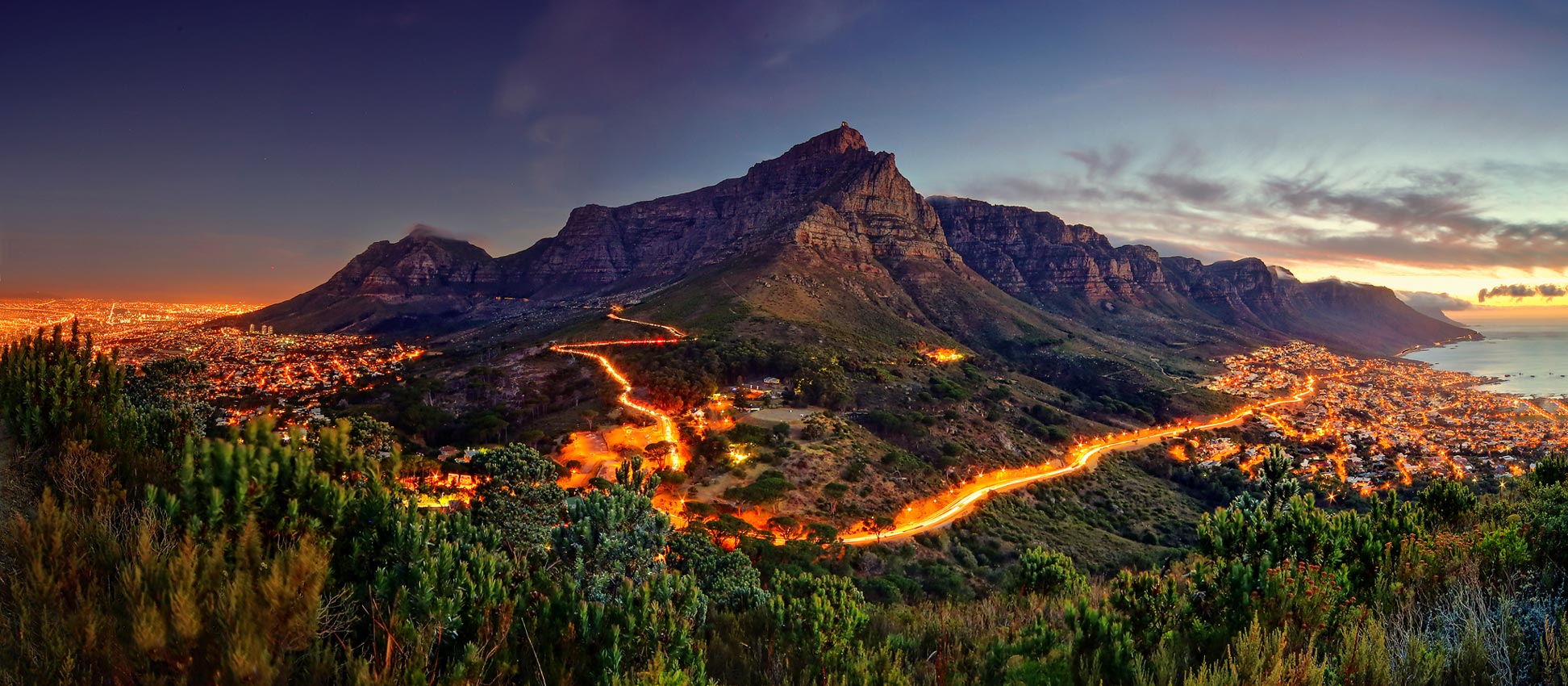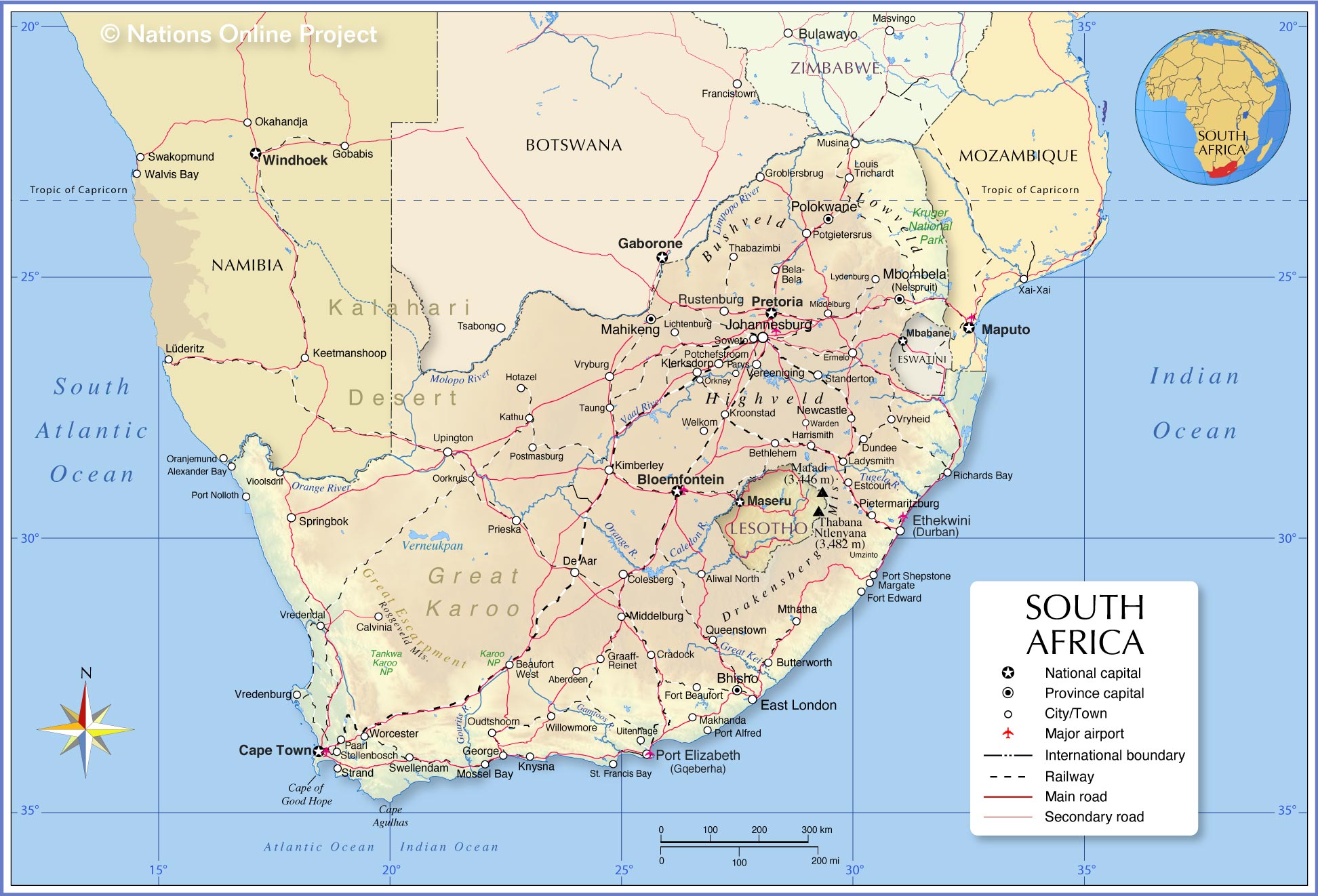About South Africa
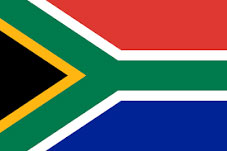 Flag of South Africa
Flag of South Africa
The map shows South Africa, the African nation that occupies the most southern part of the continent. The country, also known as the
Rainbow Nation, borders
Namibia,
Botswana,
Zimbabwe,
Mozambique and
Eswatini (Swaziland). The
Kingdom of Lesotho, a small, landlocked mountainous country, forms an enclave within South Africa. South Africa borders the Atlantic Ocean to the west and the Indian Ocean to the south and southeast.
South Africa covers an
area of 1,221,000 km². Compared, it is somewhat larger than twice the size of
France or slightly less than twice the size of the US state of
Texas.
The country has a
population of 59.6 million people (
official estimate 2020). South Africa is the only country in the world with three capitals; administrative capital is
Pretoria; legislative capital is
Cape Town, the former capital of the British Cape Province; the judicial capital is
Bloemfontein (Mangaung). The Constitutional Court is located in
Johannesburg, South Africa's largest city.
There are eleven official
languages in South Africa. The most commonly spoken languages are Afrikaans, English, Sepedi and Sesotho; the others are Swazi (siSwati), Tsonga, Tswana, Venda, isiXhosa and isiZulu.
More about South Africa
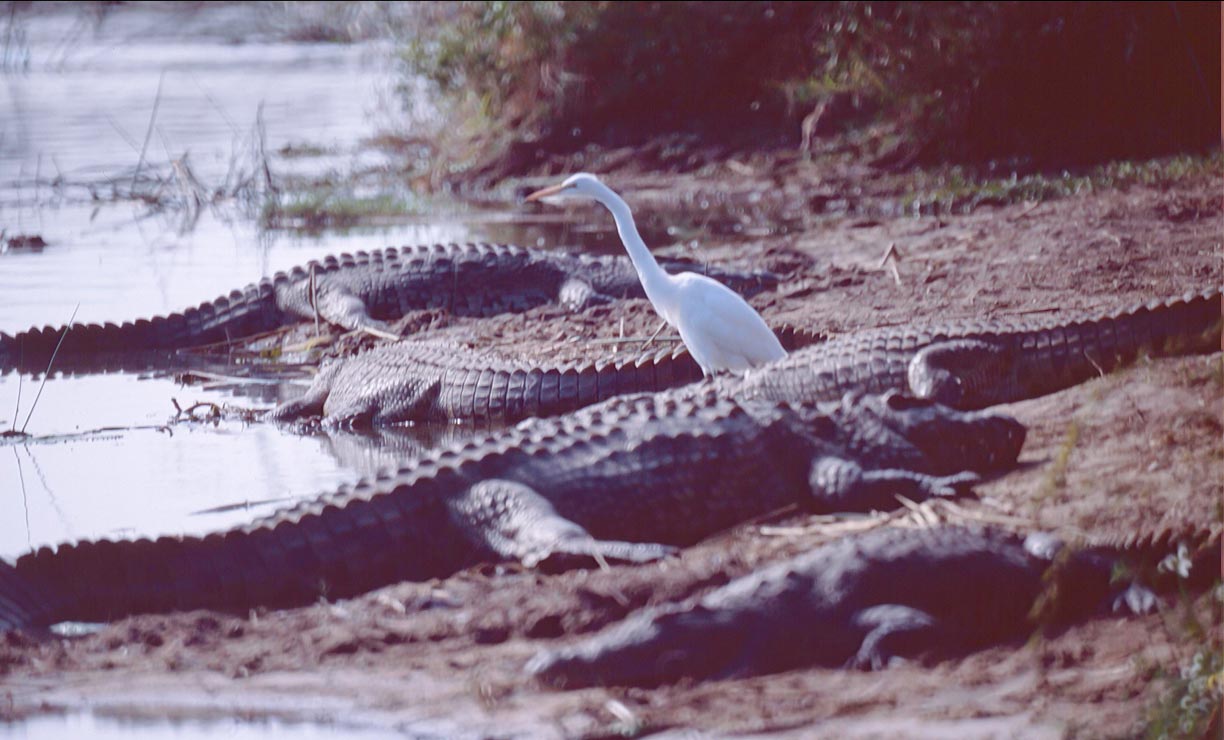 Kruger National Park, South Africa, a Yellow-billed Egret among a group of Nile crocodiles. The game reserve was established in 1898 by President Kruger and became a national park in 1926.
Photo: Patrik M. Loeff
Kruger National Park, South Africa, a Yellow-billed Egret among a group of Nile crocodiles. The game reserve was established in 1898 by President Kruger and became a national park in 1926.
Photo: Patrik M. Loeff
South Africa is about twice the size of France; its landscape includes grasslands, scrublands, forests, deserts, mountains, coastal wetlands and a 2,700 km long coastline on the South Atlantic Ocean to the west and the Indian Ocean to the east.
The territory of South Africa is dominated by a huge
Central Plateau, which is framed by the ridges of the
Great Escarpment that separates the plateau from the narrow coastal lowlands.
The country is home to almost 300 mammal species, about 860 bird species and 8,000 plant species.
Cape Agulhas is the southernmost point of the African continent. The 20th meridian, located on Cape Agulhas, represents the imaginary boundary between the Atlantic Ocean and the Indian Ocean.
South Africa's Velds
Velds are mainly the flat or plateau-like regions in the interior of the country.
The
Bushveld is a sub-tropical woodland ecoregion north of Pretoria and the
Witwatersrand ridge.
The
Highveld is the name given to the highlands of South Africa that slope down towards the north. The vegetation is mainly grassland; only in the hills and the river terraces there is scrubland.
Mountains
The highest mountains South Africa's are almost all peaks of the
Drakensberg ("Dragon Mountains"), the eastern section of the Great Escarpment. The highest mountains of the Great Escarpment, with altitudes ranging from 2,000 to 3,482 meters, are located in the border region of South Africa and Lesotho. The highest mountain in South Africa is
Mafadi at 3,450 m (11,320 ft), a peak on the border of South Africa and Lesotho. The highest mountain in the Drakensberg range is
Thabana Ntlenyana (at 3,482 m), located in Lesotho.
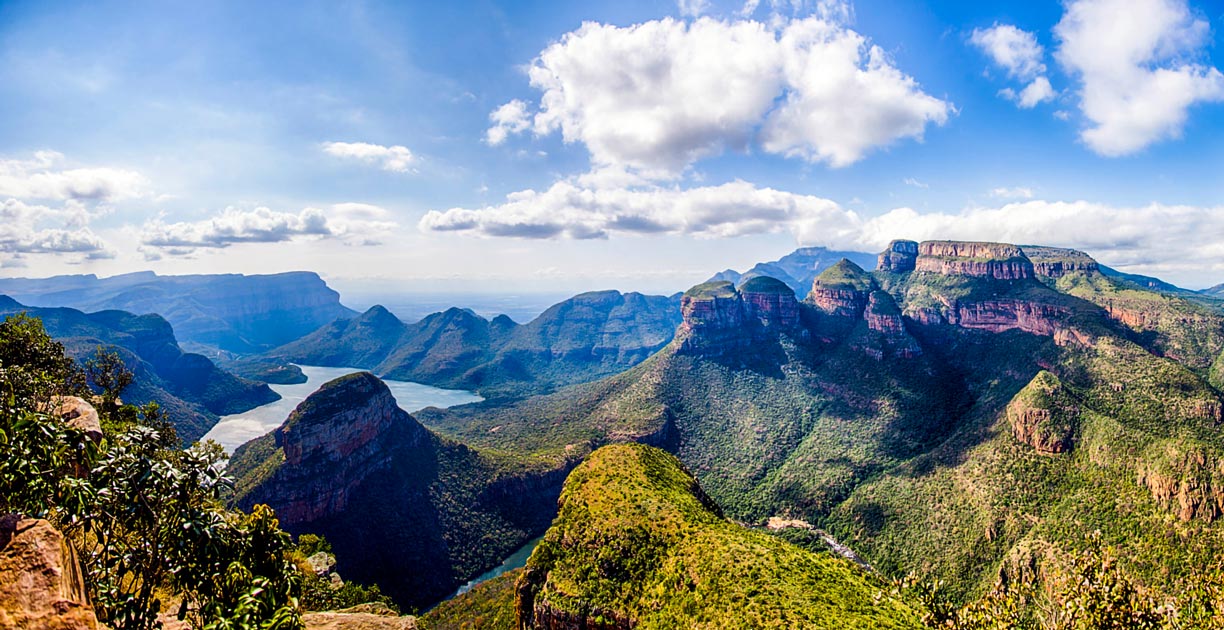 View of the Blyde River Canyon from Three Rondavels View Point. The three Rondavels and Mapjaneng table mountain to the right. The Blyde River Canyon Nature Reserve is situated in the Drakensberg escarpment region of eastern Mpumalanga, about 100 km north of Mbombela (Nelspruit).
View of the Blyde River Canyon from Three Rondavels View Point. The three Rondavels and Mapjaneng table mountain to the right. The Blyde River Canyon Nature Reserve is situated in the Drakensberg escarpment region of eastern Mpumalanga, about 100 km north of Mbombela (Nelspruit).
Photo: John Detweiler
The longest river in southern Africa is the
Orange River (from Afrikaans/Dutch: Oranjerivier). The river rises in the Drakensberg Mountains in northeastern Lesotho and flows west for about 2,000 km; it forms Namibia's southern border with South Africa and flows into the Atlantic Ocean. The largest tributary of the Orange River is the
Vaal River. The 1,120 km long river rises north of Ermelo in the province of Mpumalanga.
The confluence of the Marico and Crocodile Rivers creates the
Limpopo River. The second largest river in South Africa generally flows eastward, where it forms part of South Africa's border with Botswana and the border with Zimbabwe; it flows through Mozambique and empties into the Indian Ocean.
Kalahari Desert
The Kalahari Desert is a vast thornbush savanna in southern Africa that encompasses much of Botswana and parts of Namibia, as well as South Africa's border region with both countries.
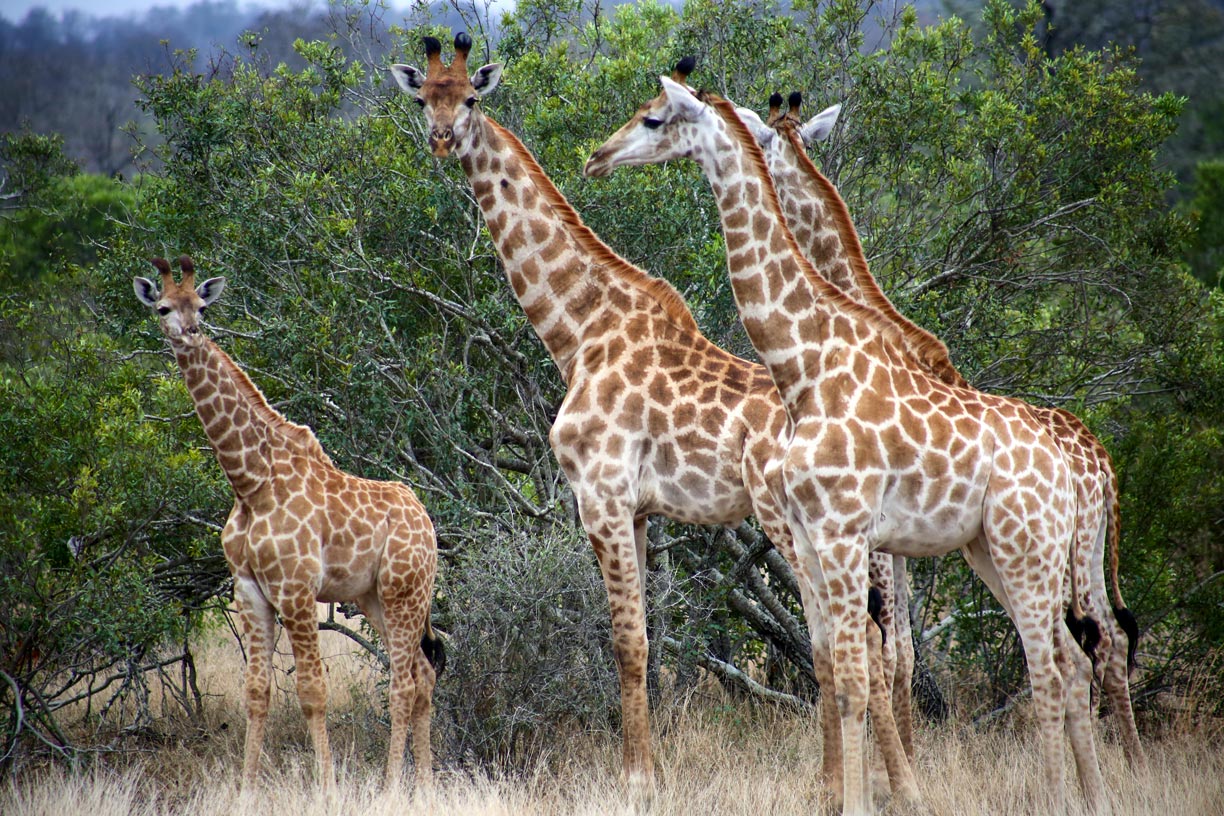 Cape giraffes in Kruger National Park. With an area of 19,623 km² the park is one of the largest game reserves in Africa.
Cape giraffes in Kruger National Park. With an area of 19,623 km² the park is one of the largest game reserves in Africa.
Photo: flowcomm
Among the more than 20 national parks in South Africa,
Kruger National Park is probably the most important and the most famous. It is one of Africa's largest game reserves and the country's first national park (est. in 1926). Since 2000, Kruger National Park has been part of a 35,000 km² transboundary protected area (TBPA), the
Great Limpopo Transfrontier Park, which links Kruger National Park with Gonarezhou National Park in Zimbabwe and Limpopo National Park in Mozambique.
The
Kgalagadi Transfrontier Park is a large game reserve in the Kalahari Desert shared by Botswana and South Africa. The park is home to big cats and hyenas as well as migratory herds of large herbivores such as gnus, springbok and other antelopes and gazelles.
The
Addo Elephant National Park is the third largest wildlife reserve in South Africa and is located near Port Elizabeth; it was established in 1931 to provide a refuge for the eleven remaining elephants in the region. Today it is home to more than 600 elephants and a large number of other mammals.
Climate
The climate of South Africa ranges from a subtropical climate in the southwestern corner, the winter rainfall region of South Africa around Cape Town. There is an arid desert climate in the northwest (Kalahari), a semi-desert climate in the Great Karoo region, while the interior Central Plateau (Highveld) has a temperate climate. Southern Africa has warmed twice as fast as the rest of the world over the past five decades, with serious consequences for the population, agriculture and the environment.
Issues South Africa
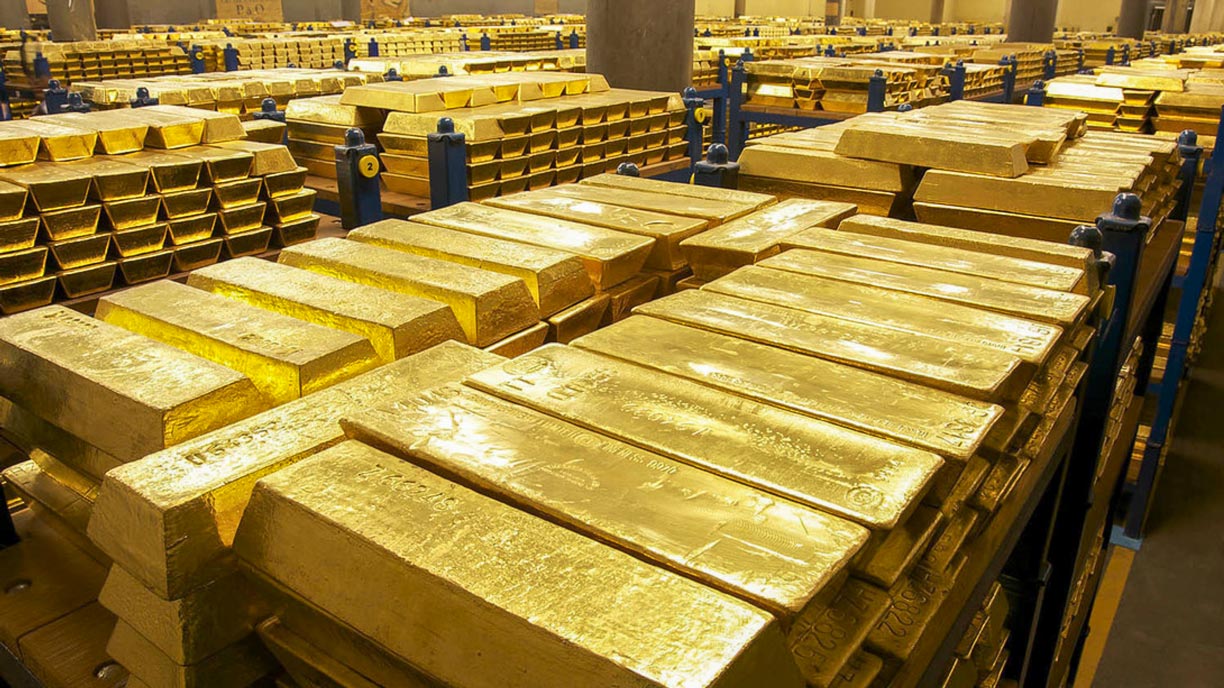 The fruits of hard labor - Pure Gold from the Mponeng Gold Mine in Carletonville in South Africa's Gauteng province. The mine lies in the center of the richest gold-mining area in the world. Gold at the Mponeng mine is mined at a depth of 3.16 km to 3.84 km. At this depth, the rock reaches a temperature of 66 °C (151 °F). To cool the tunnel air to below 30 °C (86 °F), ice slurry is pumped underground.
The fruits of hard labor - Pure Gold from the Mponeng Gold Mine in Carletonville in South Africa's Gauteng province. The mine lies in the center of the richest gold-mining area in the world. Gold at the Mponeng mine is mined at a depth of 3.16 km to 3.84 km. At this depth, the rock reaches a temperature of 66 °C (151 °F). To cool the tunnel air to below 30 °C (86 °F), ice slurry is pumped underground.
Photo: MPO Mine
South Africa is rich in various natural resources, including sugar and timber, but the real exports are metals and minerals such as gold and diamonds, platinum, vanadium and ferrochrome. Other important resources are chrome, manganese and vermiculite, coal, iron ore, manganese, nickel, phosphates, tin, and rare earth elements. In addition to gold, platinum and iron ore, South Africa's chief exports are cars, corn, fruits, wine, sugar, and wool.
South Africa's Environmental Issues
The main environmental problems of South Africa are
Pollution (water and air), especially through mining, electricity generation (coal), and other industries such as smelters, cement factories, and chemical factories. Additional pollution of rivers comes from agricultural runoff and urban discharge. Since there are no major rivers or lakes, water consumption is growing faster than supply.
Lack of energy, power plant failures repeatedly occur in the country, leading to widespread power outages as supply falls short of demand. More than 80% of the country's electricity is produced from coal. Deforestation, the total area of humid primary forest in South Africa decreased by 9.0% in the last decade.
[GFW] The disruption of fragile ecosystems has resulted in significant plant extinctions. Since there are no major rivers or lakes, water consumption is growing faster than supply.
Deforestation, the total area of humid primary forest in South Africa decreased by 9.0% in the last decade.
[GFW] The disruption of fragile ecosystems has resulted in significant plant extinctions.
South Africa's Natural Hazards
Natural disasters are rare in South Africa, but many human-made hazards can lead to disasters, such as mining disasters, environmental disasters (oil spills), and terrorist incidents.
The map shows the location of the following South African cities and towns:
Aberdeen, Aliwal North, Amanzimtoti, Beaufort West, Bethlehem, Bhisho, Bloemfontein (judicial capital of South Africa, Sesotho name is Mangaung), Calvinia, Cape Town (third most populous city and the legislative capital), De Aar, Durban (major seaport and the third largest city), East London, Ermelo, Estcourt, George, Graaff- Reinet, Hotazel, Johannesburg (largest city and industrial and mining capital), Kathu, Kimberley, Klerksdorp, Knysna, Kroonstad, Ladysmith, Mafikeng, Makhanda, Middelburg, Mossel Bay, Mthatha, Musina (Messina), Nelspruit (Mbombela), Newcastle, Oorkruis, Orkney, Oudtshoorn, Paarl, Pietermaritzburg, Polokwane (formerly Pietersburg; capital of Limpopo province), Port Alfred, Port Elizabeth (major seaport), Port Nolloth, Port Shepstone, Postmasburg, Pretoria (administrative capital of South Africa), Prieska, Queenstown, Richards Bay, Rustenburg (a major city in North West Province), Springbok, Stellenbosch, Strand, Swellendam, Uitenhage, Upington, Vereeniging, Victoria West, Vioolsdrif, Vredenburg, Vredendal, Vryheid, Welkom, and Worcester.
Advertisements:

